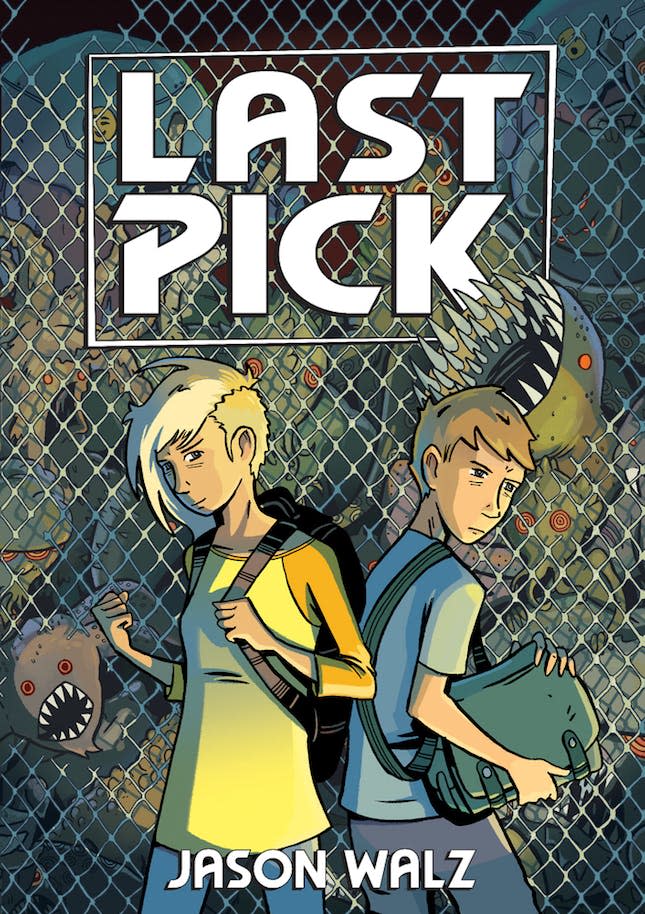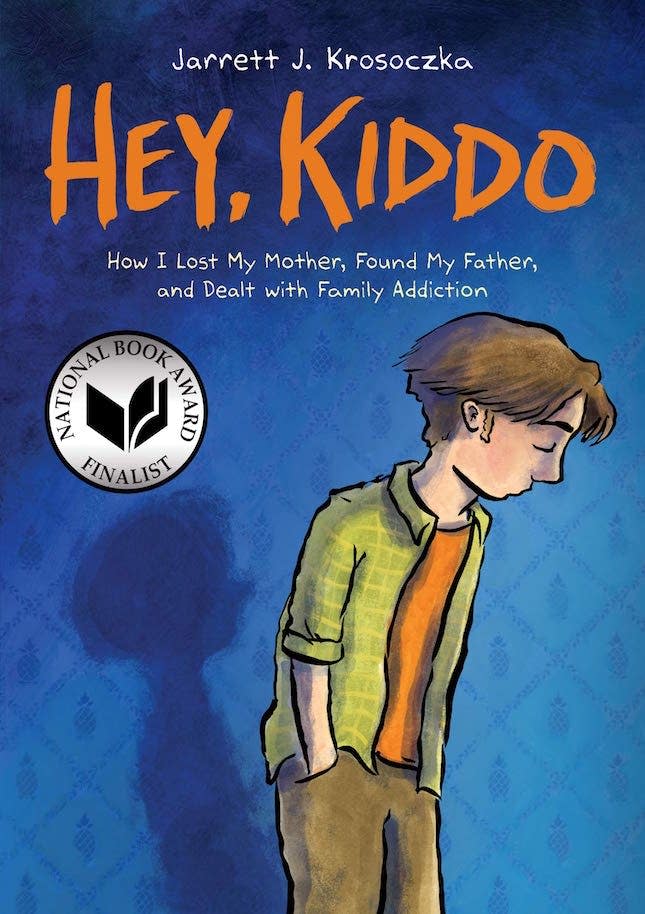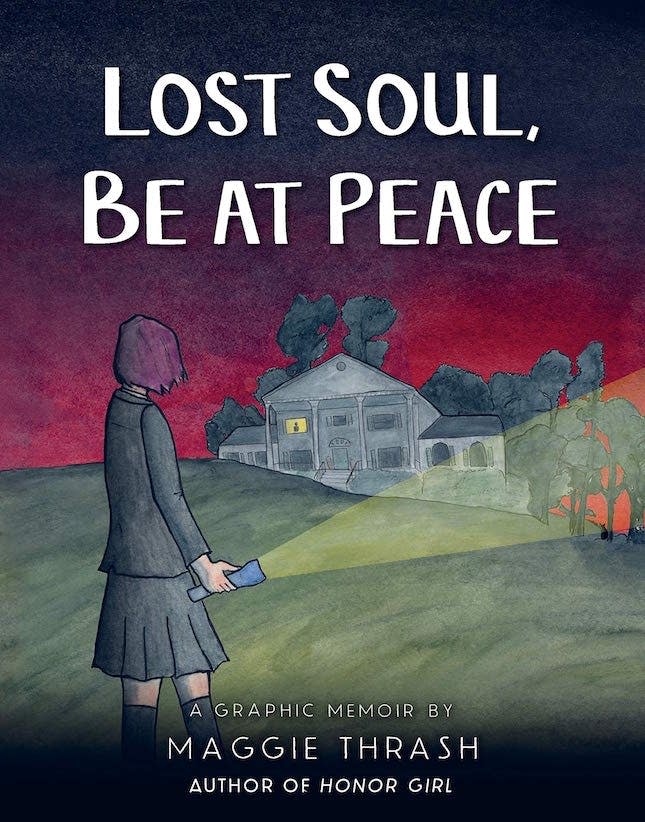3 New Graphic Novels About Coming of Age
The new graphic novels in this week’s book club provide more than just an academic panel on the coming-of-age experience; their panels, full of striking images and quick-witted banter, capture the pain and amazement of growing up. Some autobiographical and some fictional, they tell relatable, familiar, and fanciful stories.
1. Hey, Kiddo: How I Lost My Mother, Found My Father, and Dealt With Family Addiction by Jarrett J. Krosoczka ($25): There is only one picture of Jarrett J. Krosoczka with both of his birth parents, taken after he graduated from college. His mother had serious substance abuse issues, and for much of his life, he didn’t even know his father. Raised by his grandparents after his mother left more and more of his needs unmet, Krosoczka was used to her disappearances by the time she failed to show up to birthdays and even his high school graduation despite her promises, writing him letters of excuse after. There were also times when her addiction caused her to spend time in rehab and prison. Though he didn’t realize the extent of his mother’s flaws until after early childhood, he did realize she was flawed — but loved her anyway.
“When you’re a kid and a teen, you’re not in control of your circumstances. But the beautiful thing about growing up is that you get to create your own reality and your own family… ultimately, your childhood realities do not have to perpetuate themselves into adulthood, not if you don’t let them. It for sure takes work. My grandfather would always tell me, ‘If you dwell on the ghosts of the past, they’ll haunt you.’ I have found the opposite to be true — if you ignore the ghosts from your past, they’ll haunt you and never let go.”
Krosoczka turned to art to make some sense of his feelings about his family life. Luckily for him, his grandparents supported his passion: Their help in putting him through art school has resulted in almost 40 books with his drawings. This mostly hand-drawn book is filled with family history, artifacts from the past, and heart. Sadly, Krosocska’s mother died of a heroin overdose while he was finishing the book, but in her expressed hope that his memoir would help people in similar situations, he knew she approved.
2. Lost Soul, Be At Peace by Maggie Thrash ($19): Thrash’s autobiographical work follows her previously critically acclaimed book, Honor Girl. In it, she chronicles her teenaged struggle with depression and feelings of isolation. Maggie lives in Atlanta; her family is left-leaning, but she still has an NRA certification and has borrowed one of her dad’s many rifles. At her prep school, her realization that she is a lesbian has so far been met with silence, which makes her nervous about approaching her parents, because they already seem to mostly ignore her.
A Phi Beta Kappa and a Harvard graduate (and federal judge) respectively, her mother and father treat Maggie with cool distance and can’t understand why Maggie is failing eleventh grade. She can’t seem to get a handle on the equally depressed Hamlet, and she has an in-class essay that she has to pass. The only reason Maggie feels she can’t give up or move away is because of her beloved cat Thomasina (Tommi). One day, though, Tommi disappears, and Maggie worries it’s because of the recent local influx of coyotes. In her exhaustive search around the house, she meets another Tommy — this one’s a ghost. Seems like she has even more in common with Hamlet than she thought; it’s time to do some investigating, which will also help her find out about herself.
“I’m always surprised when my dad says my name. For some reason I expect him to call me ‘Miss Thrash,’ or ‘Tenant’…The house suddenly seemed vacuously huge when my brother left for college. It’s not like he was such a sparkling, sunny presence. He’s a grim introvert just like my dad. But it was nice having him around. We would watch Babylon 5 after school and make microwave s’mores, which is fun with a friend, but by yourself is kind of depressing. The other day I realized I’m the same age as Aurora from Sleeping Beauty, which makes me want to crawl into a hole and die. Not just because of the pressure that I should be taller and more charming by now, but because by the age of sixteen, Aurora had already snagged her happy ending, and her story was over.”

3. Last Pick by Jason Walz; Illustrated by Jason Walz with Jon Proctor ($25): “Three years ago — 864 days, to be exact — billions of people between the ages of 16 and 65 were whisked away from us. And now this planet is lousy with aliens. But remember when it wasn’t?” Walz’s graphic novel, the first in a trilogy, is a fictional rather than an autobiographical work. However, there’s still a lot of growing-up goodness for its main characters, 16-year-old fraternal twins Sam and Wyatt. As the neurotypical twin, Sam has always taken the lead in making sure no harm comes to her brother, who displays traits consistent with being on the autism spectrum. Schoolyard bullies are one thing, but the aliens are… unexpected.
These aliens have taken over the earth by capturing all humans between the ages of 16 to 65, except for a few. Those younger than 16 and older than 65, and those who are the correct age but have a disability, are deemed not to be useful. They’re left on Earth, under the restrictive and watchful eye of the alien forces. They’re all “last picks,” and they’re the only ones who can fight back. So now Sam and Wyatt are hiding out, trying to use alien technology to find out where everyone, including their parents, has been taken. And Wyatt, who had a hard time dealing with the world even before the aliens, must learn to take charge and protect others.
Walz, who’s also a teacher, writes, “Unfortunately, the world often has a narrow view of what success looks like. There are people out there that need all of us to look and act in very specific ways, which means that some of my students are at a severe disadvantage. The arbiters of what qualifies as success don’t realize that thinking and acting differently is what makes living on planet Earth so exciting and that we could all use a bit more of it.” His graphic novel is an ode to the power of difference, which is a message we could all use to grow up a little more.
Which books paint the perfect picture? Tag us in your next graphic read @BritandCo.
Brit + Co may at times use affiliate links to promote products sold by others, but always offers genuine editorial recommendations.




